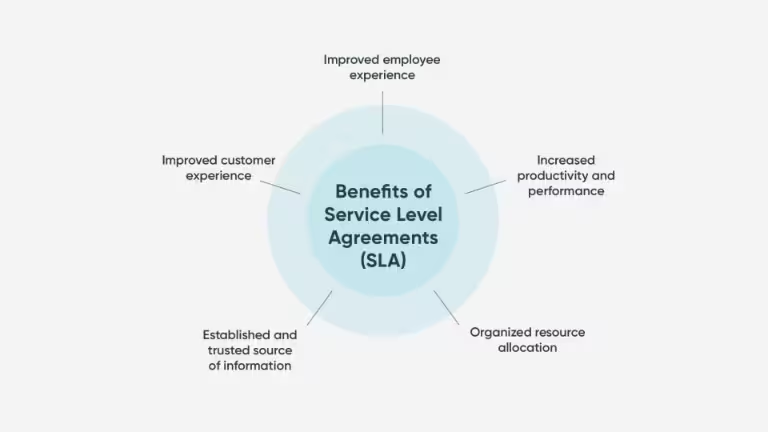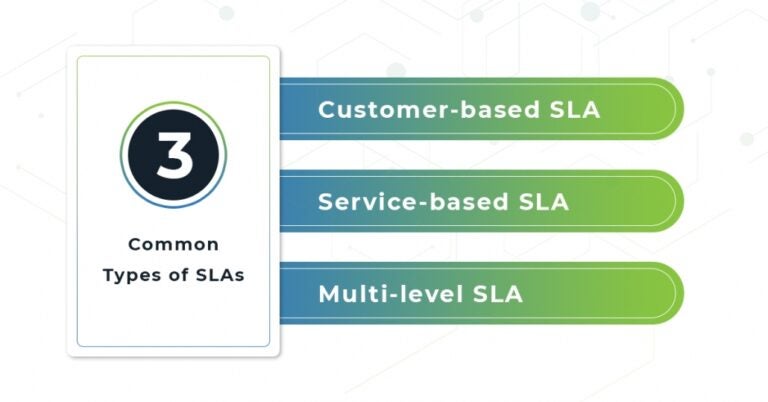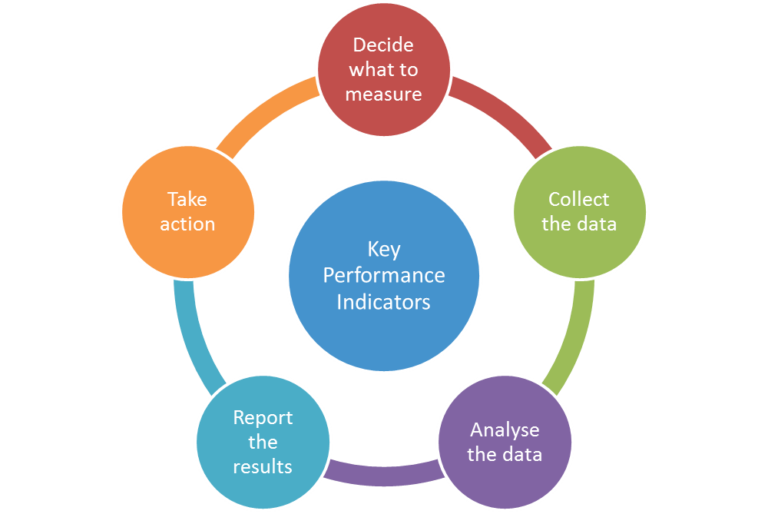Key takeaways
In the complex world of project management, ensuring clear communication, setting expectations, and delivering high-quality services are paramount. One crucial tool that helps achieve these goals is the service-level agreement (SLA).
What is an SLA in Project Management?
A service-level agreement (SLA) is a formal contract between a service provider and a client or clients defining expected levels of service. In project management, SLAs are vital for setting clear expectations, outlining responsibilities, and ensuring all the involved parties understand the requirements for the project to be completed successfully. SLAs are an essential project management tool especially when dealing with multiple stakeholders or external vendors.
Understanding SLAs in Project Management
An SLA document is a contract that all relevant parties agree upon in a project management context. It details the specific services a provider will deliver and the standards they must meet. It also lays out the expectations for the quality, availability, and responsibilities of the service, to ensure the project runs smoothly.
Service-level agreements usually include a detailed description of the service, the provider’s responsibilities, client’s responsibilities, performance metrics, and remedies to address failure for meeting the agreed-upon standards.

SLAs aren’t simply technical documents but project management tools that keep project goals aligned with client needs and expectations. They provide a framework for accountability, which can serve as a point of reference throughout the project’s duration.
Furthermore, SLAs in project management prevent misunderstandings, defuse disputes, and encourage a collaborative environment. With a service-level agreement for project management, you can clearly define the scope of the work, timelines, performance metrics, and remedies for non-compliance. An SLA document provides a structure for your project, greatly increasing your chance of success.
Why you need an SLA
You should have a well-defined service-level agreement for project management for the following reasons:
Clarity and transparency: SLAs should remove any project ambiguity by clearly defining services each party is delivering, and the standards they will meet.
Alignment of expectations: An SLA helps to ensure that all parties have agreed upon the project’s goal and how they will measure its success.
Accountability: Service-level agreements in project management establish accountability for both the service provider and the client. This ensures their responsibilities are clearly assigned.
Risk management: A good SLA document details the remedies for non-compliance. This helps manage any risks associated with delivery of services.
Continuous improvement: An SLA is something its involved parties will regularly review and update. This provides opportunities to improve processes over time.
The importance of SLAs in managing expectations and deliverables
Service-level agreements are crucial for managing expectations and deliverables in project management. They are a communication tool, which outlines both the service provider and client’s expectations. When you establish clear standards for service delivery, project management service-level agreement will help to avoid any misunderstandings so all parties strive towards the same goals.
If you have a project with multiple vendors or stakeholders, SLAs function to coordinate these parties to ensure they all are aligned and effectively collaborating and working together. This is especially important in more complex projects where, if one part fails, it can impact other parts, causing a cascading effect.
Read more: Project Management Communication Plan
Best practices for SLAs
If you want to create an effective service-level agreement for project management, you should adhere to the following best practices to ensure your SLA document is comprehensive, clearly defined, and can be enforced.
Be specific. You should clearly define the scope of services, performance metrics, and each party’s responsibilities. Using vague or ambiguous language can lead to misunderstandings.
Make sure metrics are measurable. Your metrics should be quantifiable so they best define the performance standards. Measurable metrics allow for objective assessment of service delivery.
Incorporate flexibility. Even though it is important to be specific, you shouldn’t be so rigid. Your SLA should incorporate enough flexibility to account for and accommodate changes to the project’s scope or service requirements.
Review and update the SLA regularly. SLAs in project management are meant to be living documents. This means they should be reviewed and updated regularly or as needed to reflect changes to the project or service requirements.
Main Types of SLAs
There are three main types of service-level agreements in project management. Each one is designed to meet different project needs. When you understand the differences, you will be able to select the right SLA for your project management needs.

Customer-based SLA
A customer-based SLA is meant to meet the needs of specific customers or clients. This SLA outlines the services provided to the customer, performance standards to be met, and all the parties’ responsibilities. Typically, this type of service-level agreement is used in projects where the service provider is delivering a customized service or product to a single client.
Service-based SLA
Service-based SLAs focus on the provided services, not the customer. It lays out the standards for a specific service provided to multiple customers. This type of service-level agreement is usually found in IT services, where the same service is provided to all the clients. This means the SLA defines the performance standards for the entire service.
Multi-level SLA
A multi-level service-level agreement is more complex because it involves multiple layers of service standards. This type of SLA is often found in large projects with different levels of service provided to multiple stakeholders, or where different services are provided under one SLA. Multi-level SLAs can be customized and tailored to meet the needs of each of the project’s different parties.
Other Types of SLAs
In addition to the three main types of SLAs, there are a few others you might want to be aware of.
Vendor SLA
A vendor service-level agreement is between a company and an external vendor. It defines the service the vendor or vendors will provide, the performance standards, and any remedies for failure to meet those standards. Vendor SLAs are essential for managing performance of third-party providers, thus ensuring they can effectively contribute to the overall success of the project.
Operational-level agreements (OLA)
An operational-level agreement outlines the responsibilities of different departments or teams within an organization. An OLA is an internal document, which supports the greater SLA by ensuring internal teams understand their roles and responsibilities in delivering the service to the client. We’re including OLAs in this list because they are vital in large organizations where multiple teams are involved in delivering a service.
Key Components of an SLA
When crafting a comprehensive service-level agreement, you should make sure you include the following key components:
Service description
The service description provides in-depth details of the service that will be provided. It should be very specific and should cover all aspects of the service. This includes scope of the work, deliverables, and project timelines.
Performance standards
Performance standards lay out the level of service to be provided. You should ensure these standards are measurable and objective and that they allow for a clear assessment of whether the service provider is meeting standards you agreed upon.
Roles and responsibilities
This section outlines the responsibilities of the service provider and the client or clients. It clearly defines who is responsible and for what. This clears up any ambiguity about each party’s role.
Monitoring and reporting
Monitoring and reporting in a project are essential for assessing whether the service provider is meeting the defined performance standards. This section of the SLA should detail how performance will be monitored, reporting frequency, and the metrics you will use to assess performance.
Penalties and remedies
Every service-level agreement should define the penalties for failing to meet the performance standards, as well as then laying out actions or remedies that will be taken if the service provider failed to meet the agreed-upon standards, including financial penalties, service credits, or other similar remedies.
Reviews and revisions
All parties who are associated with an SLA should regularly review and update it to ensure it remains relevant and effective. This section simply provides a process for reviewing the service-level agreement, how often you review it, and what each participant’s responsibilities are.
Escalation procedures
These describe the steps the client should take so that any potential service disruptions are promptly addressed according to the steps laid out in the service-level agreement document. Clients might take actions such as sending a notification email to the responsible team, or escalating to upper management if the SLA threshold is exceeded.
Read more: Vertical vs Horizontal Project Management
How to Create an SLA
Creating an effective, comprehensive service-level agreement involves a series of steps.
Steps to drafting a comprehensive SLA document
- Identify the services: To start, you should lay out and clearly define the service or services that will be provided. You should include details and descriptions of the services, the scope of the work needs, and any deliverables.
- Define the performance standards: Next, establish the performance standards by which the service provider will be measured. These must be based on the client’s expectations and what the service provider is capable of delivering.
- Assign the roles and responsibilities: Lay out the roles and responsibilities of both the service provider and the client or clients. This section details who is responsible for what and each of the specific tasks the involved parties will perform.
- Develop monitoring and reporting mechanisms: A well-crafted SLA establishes mechanisms for monitoring and reporting on performance. In this section, you should include details on how to measure performance, how frequently to report on it, and what metrics you will use.
- Include penalties and remedies: There should be consequences for failing to meet the defined performance standards. In this section, you should lay out the details of the penalties for non-compliance as well as how you will address or remedy them.
- Review and revise as needed: Finally, lay out how the involved parties will review and revise the SLA. This should include the process and frequency of reviews and how you will then make revisions to it.
Tips for crafting effective SLAs in project management
While a series of steps for creating a service-level agreement document might seem like enough to create something basic, there is real art for crafting an SLA that is truly effective for project management.
Involve all stakeholders. Communicating with stakeholders is crucial in this process; you want to make sure all of them are involved in creating the SLA. This document will reflect the needs and expectations of all parties, so make sure everyone with a stake in it is looped into its creation.
Be clear and concise. Don’t be wordy and vague. You should be as articulate, clear, and concise as possible so as to avoid ambiguity and confusion. Make sure the SLA is easy to understand and doesn’t rely on technical jargon to get its points across.
Define measurable outcomes. Performance standards that can be measured and are objective will make it far easier to assess whether the service provider is meeting the agreed-upon standards.
Be flexible. Even though we stress that a service-level agreement should be clear and specific, it should also include enough wiggle room to accommodate revisions to the project’s scope and service requirements.
Key Performance Indicators (KPI) and Metrics of SLAs
Key performance indicators or KPIs are the primary key in measuring a service-level agreement’s effectiveness and success in project management.

All KPIs should closely align with the performance standards you’ve defined in the SLA document, and they should clearly indicate whether the service provider is meeting the agreed-upon standards. Common key performance indicators in service level agreements for project management include response time, resolution time, service availability, and customer satisfaction.
Read more: What Are Milestones in Project Management?
FAQs
Bottom Line: The Critical Role of SLAs in Project Management Success
Service-level agreements are very important tools in project management. They provide a structured framework needed to manage expectations, define responsibilities, and ensure all parties are held accountable. When the provided services are clearly outlined, the standards to be met are well defined, and the consequences for non-compliance are defined, an SLA will ensure any project is delivered successfully, and all parties involved are satisfied. Effectively crafted SLAs will significantly increase the project’s chance for success, which makes them essential to any project management strategy.





